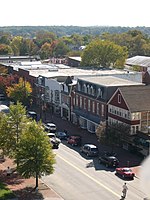Charles Sumner Post No. 25, Grand Army of the Republic

Charles Sumner Post #25, Grand Army of the Republic is a historic fraternal lodge building located in Chestertown, Kent County, Maryland. Named after Charles Sumner, it was constructed as a meeting hall about 1908 and is a two-story gable-front frame building, built on brick piers, with a rectangular floor plan. It is located in the Scotts Point area, a historically black area within the Chestertown Historic District, and was abandoned between 1985 and 2002. It is one of only two Grand Army of the Republic halls for African-American veterans known to survive in the Nation.It was listed on the National Register of Historic Places in 2005. In 2012, Preservation Maryland placed the Charles Sumner Post #25 on its list of threatened historic properties.The building has been restored by the Kent County Arts Council and opened to the public in 2014 as a museum of American Civil War history and the role of African-Americans in the war.
Excerpt from the Wikipedia article Charles Sumner Post No. 25, Grand Army of the Republic (License: CC BY-SA 3.0, Authors, Images).Charles Sumner Post No. 25, Grand Army of the Republic
Cannon Street,
Geographical coordinates (GPS) Address Nearby Places Show on map
Geographical coordinates (GPS)
| Latitude | Longitude |
|---|---|
| N 39.206875 ° | E -76.065208333333 ° |
Address
Cannon Street 132
21620
Maryland, United States
Open on Google Maps









